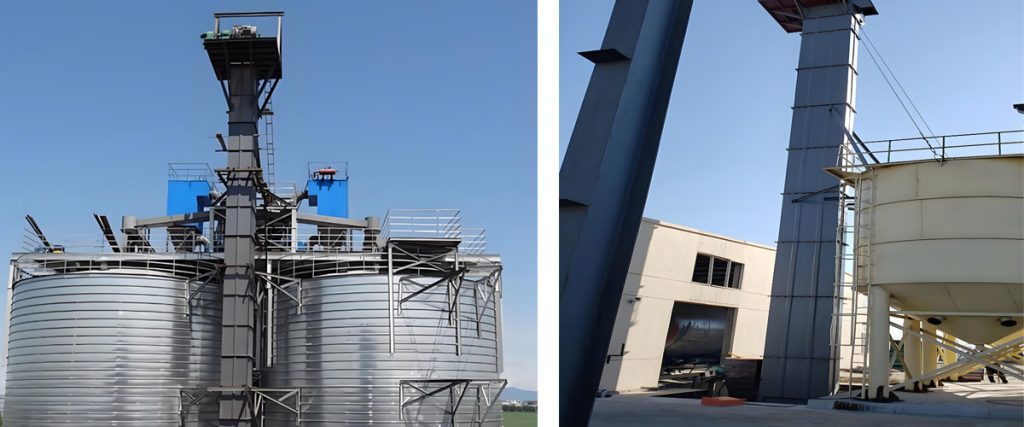Bucket elevator is a high-efficiency vertical conveying equipment, which is widely used in the continuous lifting operation of materials from low to high. The equipment can realize automatic continuous operation and vertical conveying after feeding materials into the hopper through the vibrating table. The conveying speed can be flexibly adjusted according to the actual conveying capacity, and the lifting height can also be customized according to user requirements.
Features of Bucket Elevator
- Customized design: all sizes can be designed and manufactured according to the actual needs of customers
- Safety material: Polypropylene non-toxic hopper is used, which meets the health standards of food, medicine and other industries
- Wide applicability: suitable for lifting and conveying of various materials such as food, medicine, chemical products, hardware parts, etc
- Intelligent control: it can be linked with the packaging machine to realize automatic start and stop control through signal recognition
- Flexible adjustment: conveying speed and lifting height can be adjusted according to production requirements
Common fault diagnosis and Solutions
1. hopper belt slipping
Possible causes and solutions:
- Insufficient tension: adjust the tensioning device, and readjust it if the stroke is insufficient
- Overload operation: reduce the feeding volume and keep it uniform, and check whether there is material accumulation or foreign matter jamming
- Insufficient friction: when the inner surface of the head wheel and hopper belt is too smooth, glue can be applied to increase friction
- Bearing problem: check the head wheel and bottom wheel bearings, clean and lubricate or replace them if necessary
- Uneven feeding: control the feeding speed and gradually increase the feeding volume after no-load startup
2. hopper belt deviation
Solution:
- Adjust the tensioning device to ensure proper tension
- Correct the verticality of the whole machine and adjust the parallelism of the head and tail wheels
- Check and correct the straightness of hopper belt joint
- Optimize the feeding position to prevent eccentric load
- Regularly check and replace worn head and tail wheels
- Replace the aging belt in time
3. prevention of hopper belt tearing
Key measures:
- Timely handle deviation and hopper falling
- Install wire mesh or magnet at the feed inlet to filter foreign matters
- Regularly check the belt for wear
4. optimization of material return
Adjustment scheme:
(1)Speed adjustment:
- Dry powder particles: 1-2m/s
- Bulk material: 0.4-0.6m/s
- Wet powder particles: 0.6-0.8m/s
(2)Clearance adjustment:
- The guide plate and hopper shall have an ideal clearance of 10-20mm
(3)Structural optimization:
- Oversized head cover size
- Adjust pulley lowering speed
- Modify hopper shape and angle
Appropriately increase the hopper spacing - Optimize hopper height design
5. preventive measures for hopper falling off
Solution:
- Control the reasonable feeding quantity to avoid the accumulation of the base
- Adjust the feed inlet to the position above the center line of the bottom wheel
- Use high strength materials to make hopper
- Clear the accumulated material in the rack before starting the machine
6. handling scheme for rack blockage
Precautions:
- Evenly control the feeding volume and monitor the position of materials through the observation window
- Reduce the amount of returned materials
- Install a check device to prevent reverse rotation
- Maintain proper belt tension
- Protective screen shall be installed at the feed inlet
7. Dust Explosion Prevention Measures
Recommended Solution: Install a vent port on the exhaust pipe at the head section to release air into the atmosphere, reducing dust concentration.

Performance Optimization Guide
Production Increase Solutions
1. Equipment Maintenance:
Regularly clean accumulated material buildup
Inspect and adjust the size and angle of the discharge chute
2. Process Optimization:
Balance production capacity between upstream and downstream equipment
Optimize the gear ratio to increase speed
Ensure optimal bucket fill rate
3. Backflow Control:
Monitor backflow levels by listening for “rain-like” sounds inside the casing
Adjust the material trajectory by fine-tuning bucket discharge
Solution of ash leakage
- Replace flange gasket and use sealant
- Strengthen the head frame seal
- Optimize feeding mode to increase buffer
Equipment vibration treatment
- Check the motor rotor balance
- Recalibrate the gear unit alignment
- Adjust the installation levelness
- Optimize the installation position and tension of head and tail wheels
Abnormal Noise Troubleshooting
1.Mechanical Adjustments:
Adjust the elastic tensioning device of the base plate
Tighten any loose components
Realign the guide plate position
2.Foreign Object Handling:
Remove any jammed or obstructing material
Inspect and eliminate foreign debris
3.Component Replacement & Adjustment:
Replace faulty bearings
Adjust belt tension/length
Installation Calibration:
Ensure proper vertical alignment of the casing
Conclusion
Bucket elevators are essential for material handling, and their stable operation ensures production efficiency. Regular maintenance and addressing common issues can extend service life and boost productivity.
For any inquiries, feel free to contact us.

